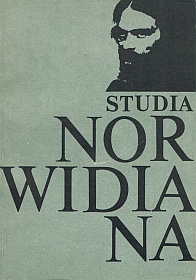Ill Fate Crucified
Abstract
Fatum from Vade-mecum, a lyrical poem so intriguing for many critics and scholars like Borowy, Szuman, Wyka, Głowiński, Zamącińska, is interpreted in the context of the whole Norwid’s literary output and of the models of romantic lyrical poetry. The author aims at showing Norwid’s attitude towards suffering which disables man like an irreversible 111 Fate or Misfortune.
Spritual fight, a mental process, is made inward by means of the metaphor ”a fight of eyes” which is given substance to by means of syllable instrumentation and compositional devices.
A comparative analysis of the Fatum points to the Christian concept of suffering where suffering is considered to be a profit rather than a loss. It would be a loss only if man did not accept suffering to his profit. It is so when man fights against the irreversible Misfortune on „its part of the battle-field”. Then he assumes the beastly armour of his opponent and destroys himself in the senseless scuffle thus becoming an Energumen of Don Quixot. Man „swerves” from his purpose when runs away from 111 Fate and alienates himself finding shelter in the delusive asylums of falsely recorded time of childhood, of a passing moment or of the future. He also swerves when assumes the heroic-stoic, infantile, moralistic, mistic, messianic or other masks of natural religiousness.
Man, however, should experience suffering and not „swerve” in the face of Misfortune. He must adopt the priestly attitude (Sfinks) towards his own history and experience it as a great celebration ”in Spirit and truth” (John 4, 23) with no division into the sacrum and profanum (Rom 12, 1-2) and with everything good and acceptable since everything comes to us directly from God (Dookoła ziemi naszej. Pieśń). Yet, in his liturgy which reflects the Mystery of the Passion sufferings resulting from all the misfortunes (but not from the sin!) occupy a priviliged place. They bear the name of the cross and render it possible to experience the Pascha that is the transition from death to resurrection [A Pani coż ja powiem?...].
Through enlightment and on becoming the cross Norwid’s 111 Fate is subdued not by way of adopting the stoic attitude [Na zgon Józefa Zaleskiego] but rather by Transcendence, a power that comes from the above (cf. Do Pani na Korczewie). Hence, many lyrical passages in Norwid’s poetry reflect a sudden change, as if reminiscent of God’s presence in earthly occurrences and especially in the cross which for the religious people is an outrage, for the wise a trifle and for the elect the power and wisdom of God (I Co 1, 17-31; 2).
Although Norwid’s Fatum conceals the mystery of the cross exactly as did primeval Christianity so fascinating for Norwid (Quidam), the poem carries the same message for those who subdue their suffering as does the one which Jehovah said unto Moses (who wished to save his people): „Make thee a fiery serpent, and set it upon a standard; and it shall come to pass, that every one that is bitten, when he seeth it shall live” (Num 21, 8). This „seeing” is Norwid’s look that heals from Misfortune. Biblical Adam, the first man, could not „see” and therefore was defeated by the Serpent; pre-Christian Socrates could „see” but was not conscious enough of his „seeing”. Only the man of the Christian era delivers himself and the whole world from 111 Fate by taking it upon himself. Christ, another Adam, revealed the mystery of the cross and now gives it to man as the armour of God for his wrestling against the worldrulers of this darkness (Eph 6, 19-20). This fight Christ had already won and now this fact guarantees man’s victory. Therefore, this is a glorious cross - radiating resurrection. It can, thus, give power and fill our spirits with the word of God. Such existential experience contests the fatal beastly power of 111 Fate. Hence, the „crucifying” of 111 Fate, understood in this sense, is something more than a mere rationalization of misfortune in order to obtain its objective essence. It is also something more than a stoic agreement to respect it out of necessity.
For, in Norwid’s world of values, the cross occupies the mean-point of the divine and human universe. The Cross of Christ is the „frame of the Earth” as it was once described by the Fathers of the Church. No wonder, then, that the cross as the ”mean-point” of the spiritual sphere: earthly, corporal, heavenly (Do słynnej tancerki rosyjskiej - nieznanej zakonnicy) in the Epilogue to Promethidion will also be called a „means” because of the ambigious meaning of the word „środek” in Polish (mean-point, centre, means, ways, also remedy). Naturally, it is a remedy for salvation of our harassed consciousness and all our existence. It is a Christian’s means of participating in the creation of art. Thus, it is also a structural principle of Norwid’s poetry.
The Christian crucifies 111 Fate and the poet „seeth” that in a crosswise view.
Copyright (c) 1983 Studia Norwidiana

This work is licensed under a Creative Commons Attribution-NonCommercial-NoDerivatives 4.0 International License.





